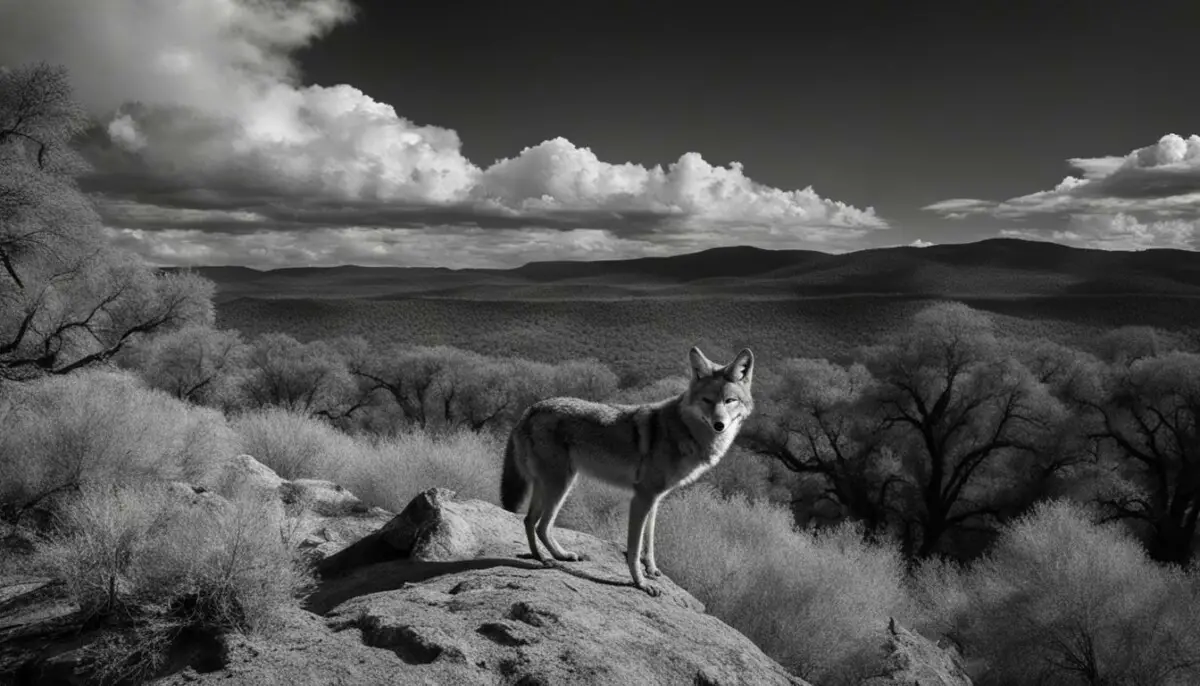Last Updated on 5 months by Francis
When it comes to the vision of coyotes, there are still many mysteries to unravel. One intriguing question that often arises is whether coyotes can see infrared light. In this article, we will explore the fascinating world of coyote vision and shed some light on this enigmatic topic.
Contents
Key Takeaways:
- Coyotes are nearsighted with a vision of around 20/75, similar to dogs.
- They have a wider peripheral vision, allowing them to detect movement in their surroundings.
- There is no evidence to suggest that coyotes can see infrared light.
- Coyotes can see well in low-light conditions and rely on their keen eyesight to navigate and hunt at night.
- The reflective nature of their eyes makes them easily visible in the dark.
Do Coyotes Have 20/20 Vision?
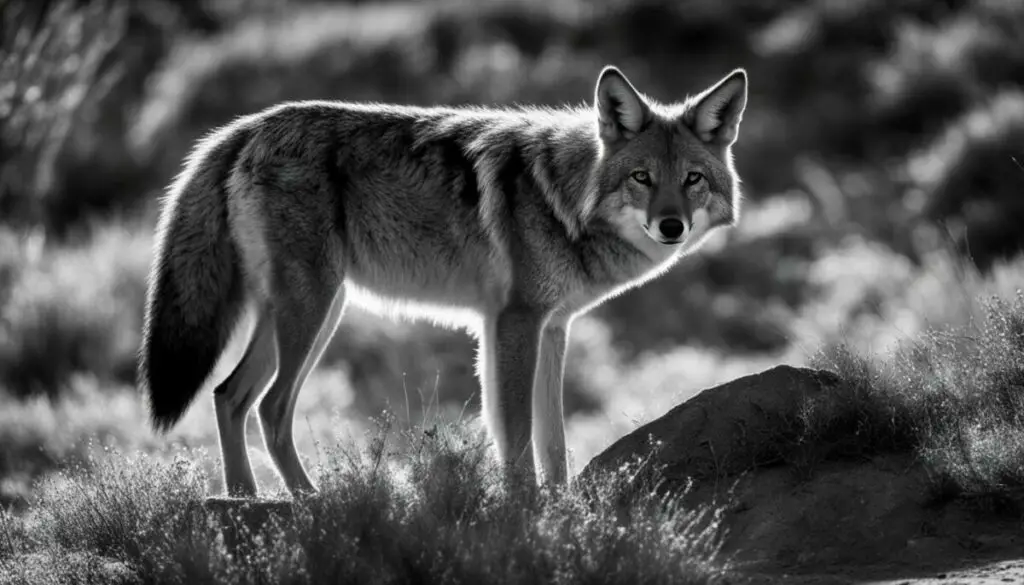
While humans have 20/20 vision, which is considered to be normal vision, coyotes do not possess the same level of visual acuity. They are nearsighted creatures, with a vision of around 20/75. This means that objects that are 20 feet away appear as if they are 75 feet away to a coyote. Their eyesight is similar to that of dogs, which is not surprising considering they belong to the same family.
However, coyotes have compensatory abilities that allow them to navigate their surroundings effectively. One of these abilities is their wide peripheral vision. Unlike humans who have a peripheral vision of around 180 degrees, coyotes have a much wider range of approximately 260 degrees. This enhanced peripheral vision enables them to detect movement in their environment more easily, making them skilled hunters and avoiding potential threats.
In summary, while coyotes do not possess 20/20 vision like humans, they have evolved with specialized adaptations that allow them to thrive in their natural habitat. Their nearsightedness is compensated by their wide peripheral vision, which gives them a distinct advantage when it comes to detecting movement and surviving in the wild.
The Visual Acuity of Coyotes
To further understand the visual capabilities of coyotes, let’s take a closer look at their visual acuity compared to other animals:
| Animal | Visual Acuity |
|---|---|
| Humans | 20/20 |
| Dogs | 20/75 |
| Coyotes | 20/75 |
As shown in the table above, both dogs and coyotes have similar visual acuity. This means that objects that appear clear to humans at 20 feet will appear blurry to dogs and coyotes, making it important for them to rely on their other sensory abilities and peripheral vision to navigate their surroundings.
Enhanced Peripheral Vision
One of the remarkable features of coyote eyesight is their wide peripheral vision. This ability allows them to see a much broader range of their surroundings compared to humans. While humans have a peripheral vision of approximately 180 degrees, coyotes can see up to 260 degrees. This wide field of view enables them to quickly detect movement and potential prey or threats.
“Coyotes have adapted to their nearsightedness by developing a wide peripheral vision, providing them with a distinct advantage in their natural environment.” – Wildlife Expert
In conclusion, while coyotes may not have 20/20 vision like humans, their nearsightedness is compensated by their enhanced peripheral vision. This adaptation allows them to effectively navigate their surroundings and spot potential prey or predators. Understanding the unique visual abilities of coyotes is crucial in appreciating their remarkable adaptations for survival.
Is The Prairie Wolf Color Blind?
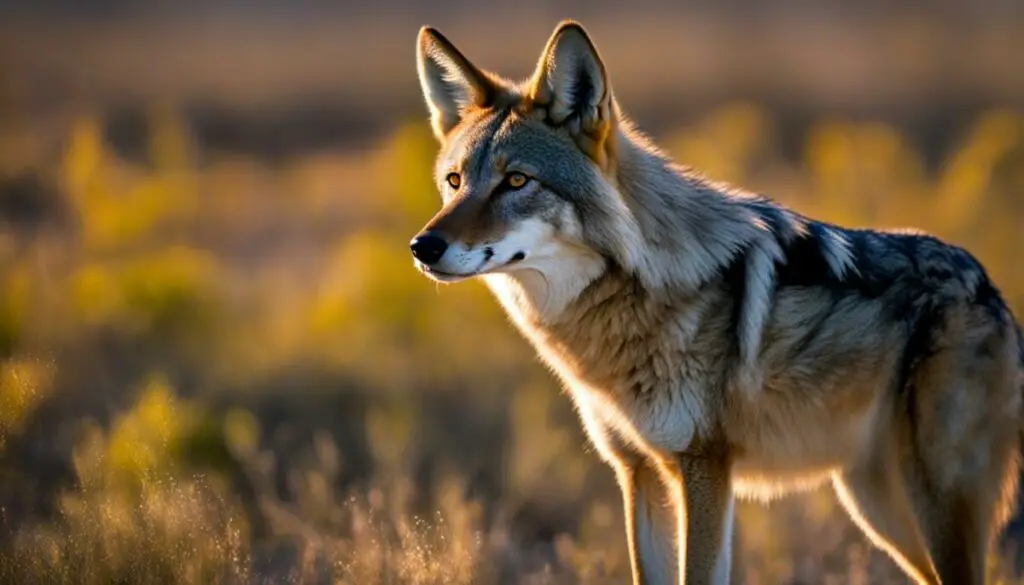
Coyotes, often referred to as prairie wolves, have a unique visual perception compared to humans. While not color blind, their color vision is limited. Coyotes have dichromatic vision, meaning they can only see two color channels: blue and yellow. Colors such as orange, green, and red appear as shades of gray to them. This limited color perception is due to the types of cones in their eyes, which are responsible for color vision.
Researchers have studied the visual abilities of coyotes extensively, yet there is no evidence to suggest that they can see infrared light. Unlike certain reptiles and birds, mammals like coyotes do not possess the necessary specialized structures in their eyes to detect infrared. Their visual system is more attuned to daylight vision, which helps them navigate and forage during the day.
“Coyotes have dichromatic vision, meaning they can only see two color channels: blue and yellow.”
Comparing Human and Coyote Vision
While humans have trichromatic vision, allowing us to see a wide range of colors, coyotes have adapted to their environment with their dichromatic vision. This adaptation helps them detect subtle changes in vegetation, which aids in camouflaging and hunting. Additionally, they have a higher concentration of rod cells in their eyes, which enhances their sensitivity to low light conditions. This adaptation gives them an advantage in spotting prey during dawn, dusk, and nighttime.
| Aspect | Human Vision | Coyote Vision |
|---|---|---|
| Color Perception | Trichromatic (various colors) | Dichromatic (blue and yellow) |
| Night Vision | Limited sensitivity | High sensitivity |
| Peripheral Vision | 180-degree field of view | 260-degree field of view |
| Visual Acuity | 20/20 vision | Nearsighted (around 20/75) |
In conclusion, while coyotes are not color blind, their color perception is limited to blue and yellow. They cannot see infrared light and rely on their keen low light vision and wide peripheral vision to thrive in their natural habitat. Understanding the visual capabilities of these fascinating creatures helps shed light on their behavior and adaptations as one of nature’s elusive predators.
Do Coyotes Struggle to See in the Dark?
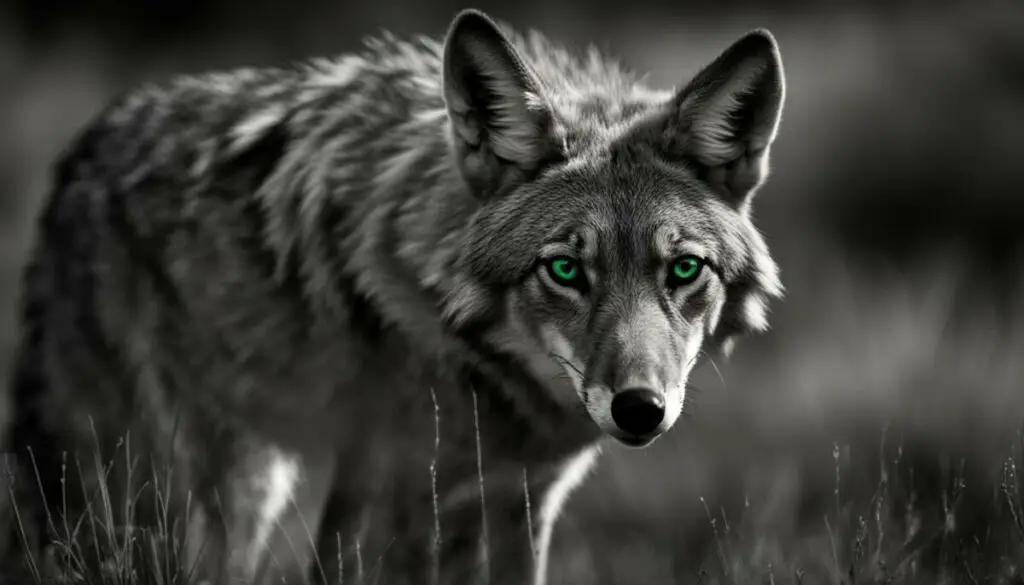
When it comes to navigating the darkness, coyotes are skilled hunters with exceptional night vision. Unlike humans, who rely on artificial sources of light, coyotes have natural adaptations that allow them to see clearly in low-light conditions. Their eyes are equipped with a specialized structure called the tapetum lucidum, which enhances their visual sensitivity.
With their reflective eyes, coyotes can gather and amplify even the faintest light available, allowing them to see details and movement in the dark. This unique adaptation gives them a significant advantage when hunting at night, helping them locate prey and avoid potential dangers.
To further aid their night vision, coyotes have a high concentration of rod cells in their retina, which are responsible for detecting light. These cells are more sensitive to dim light than the cone cells that provide color vision. As a result, coyotes can see well in low-light conditions, even without the need for artificial illumination.
While coyotes are naturally diurnal animals, their ability to see in the dark makes them versatile predators that can adapt to different lighting conditions. They take advantage of their enhanced night vision to hunt when their prey is most active, which often occurs during the twilight hours or in the cover of darkness.
With their remarkable night vision capabilities, coyotes are truly masters of the dark. Their ability to see clearly in low-light conditions allows them to thrive in a variety of habitats, making them one of the most successful carnivores in North America.
Can You See the Eyes of a Coyote in The Dark?
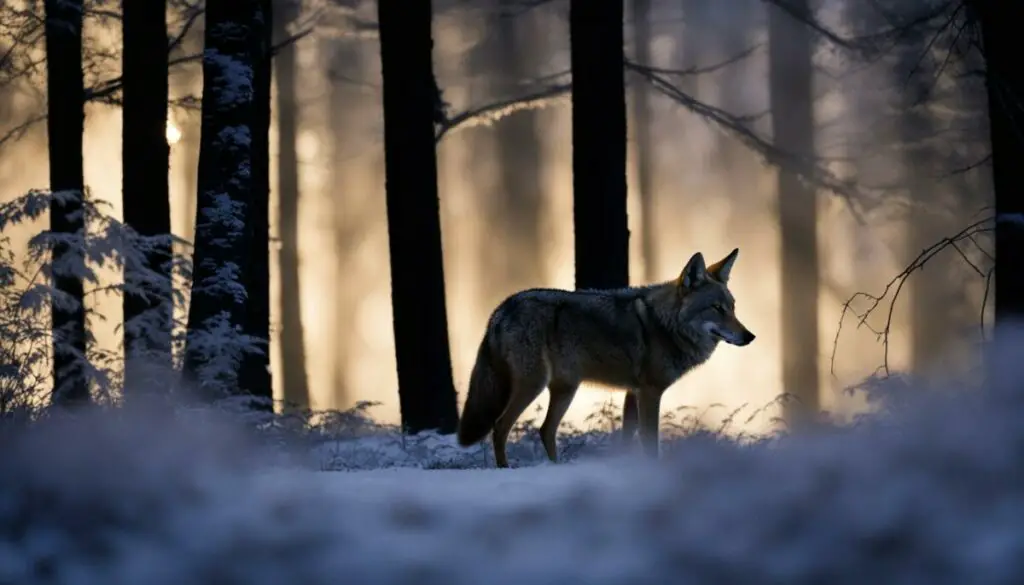
The reflection of a coyote’s eyes is a striking sight in the dark. Their eyes possess a tapetum lucidum, a layer of tissue behind the retina that enhances their vision in low-light conditions. This biological reflector system allows them to gather and make the most of available light, making their eyes highly visible even to those with poor night vision. The bright white glow of their eyes can be easily seen in the darkness, adding to the mystique of these fascinating creatures.
“The reflective eyes of coyotes are a mechanism that helps them see better in the dark while remaining concealed from predators.”
The tapetum lucidum not only provides coyotes with better vision in dim lighting but also aids them in tracking their prey. This feature is not unique to coyotes; many nocturnal animals have eyes that reflect light. It is important to note that the presence of reflective eyes does not guarantee that you are encountering a coyote specifically. Other animals, such as deer, also possess this characteristic. To differentiate between species, experienced observers must consider additional clues, such as eye placement and size.
To better understand the reflective quality of coyote eyes, imagine shining a light in a dark forest. When the light hits the eyes of a coyote, the tapetum lucidum reflects the light back, creating a bright glow. This reflective property makes it easier for us to spot coyotes and other nocturnal creatures. However, it is crucial to exercise caution and maintain a safe distance when encountering wildlife, as coyotes can be dangerous if provoked.
| Fact | Information |
|---|---|
| Coyote Eyes at Night | Highly reflective |
| Reflective Mechanism | Tapetum lucidum |
| Function of Reflective Eyes | Better vision and prey tracking in low-light conditions |
| Visibility in Darkness | Easily spotted, even by those with poor night vision |
What’s The Natural Color of Coyote’s Eyes?

Coyotes have a range of natural eye colors, adding to the intrigue of their vision. Their eyes can be shades of yellow, golden brown, lemon, blackish-brown, reddish-brown, or even orange. Interestingly, some adult coyotes maintain the blue eye color typically associated with younger individuals. The variety in eye color among coyotes is still being researched, and scientists are working to understand the factors that determine these differences.
While the exact reason for such diverse eye colors in coyotes is not yet fully understood, it is thought to be influenced by genetic and environmental factors. These variations add to the unique beauty of these animals and make each individual coyote visually distinct.
Understanding the natural eye colors of coyotes can be helpful for wildlife enthusiasts and researchers who study these intriguing creatures. By observing and documenting the different eye colors exhibited by coyotes, experts can gain insights into their population dynamics and genetic diversity.
| Eye Color | Description |
|---|---|
| Yellow | Shades of yellow, ranging from pale to deep golden yellow. |
| Golden Brown | Rich golden brown color with hints of amber. |
| Lemon | Pale yellowish color similar to the citrus fruit. |
| Blackish-Brown | Dark brown color that appears almost black. |
| Reddish-Brown | Brown color with reddish undertones. |
| Orange | Bright orange color, though less common in adult coyotes. |
Each coyote eye color adds to the fascinating nature of these animals, making them even more captivating to observe in the wild. Whether it’s their yellow, golden brown, lemon, blackish-brown, reddish-brown, or orange eyes, coyotes continue to intrigue researchers and nature enthusiasts alike with their unique visual characteristics.
Does The Color of Coyote’s Eye Change as The Sun Sets?

As the sun sets and the light changes, it’s natural to wonder if the color of a coyote’s eye also undergoes a transformation. However, the color of a coyote’s eyes remains consistent regardless of the time of day. Whether it’s day or night, if the eyes appear yellow during the daytime, they will still appear yellow in the darkness. This constancy in eye color is due to the pigmentation and structure of the coyote’s eyes.
The white reflective glow that can be seen in a coyote’s eyes, especially when light is shined upon them, is caused by a layer of tissue called the tapetum lucidum. This biological reflector system enhances the coyote’s night vision by bouncing light back through the retina, allowing for increased sensitivity in low-light conditions. While the tapetum lucidum may create the appearance of a color change, it is simply a reflection of the light source and does not alter the natural color of the eye.
It’s important to note that the reflective glow in a coyote’s eyes is not unique to them. Many other nocturnal animals, such as deer, also exhibit this feature. The tapetum lucidum serves the same purpose in a variety of species, enhancing their ability to see in the dark. Therefore, relying solely on the reflective glow to identify a coyote may lead to a misinterpretation. Other factors, such as the size and placement of the eyes, should also be considered when determining the species of an animal.
Is The White Reflective Glow an Obvious Sign You’re Seeing a Coyote?
The white reflective glow in a coyote’s eyes is not unique to coyotes alone. Many nocturnal animals, such as deer, also exhibit this feature. The tapetum lucidum, a biological reflector system behind the retina, causes this glow. It enhances their ability to see in low-light conditions by reflecting light back through the retina, increasing visual sensitivity. Therefore, seeing the white reflective glow in a pair of eyes does not immediately indicate that you are in the presence of a coyote. Other animals can also have reflective eyes, making it important to consider additional clues when identifying the species.
Experienced hunters and wildlife enthusiasts use various factors to differentiate between different species based on their eyes. One such factor is eye placement. Coyotes have eyes positioned in a manner similar to other predators, facing forward. This arrangement provides them with binocular vision, allowing for accurate depth perception and better focus on their prey. Additionally, the size of the eyes can also provide valuable information. Coyotes typically have medium-sized eyes, which, combined with their eye placement and reflective glow, can help distinguish them from other animals.
While the white reflective glow in a coyote’s eyes is fascinating and eye-catching, it is essential to approach these animals with caution. Coyotes are known to be dangerous and should be observed from a safe distance. If you encounter a coyote, it’s best to give them plenty of space and avoid any interaction. Enjoy their beauty and unique characteristics from afar, ensuring both their safety and yours.
Quick Facts About Coyote Eyesight:
- Coyotes have nearsighted vision, similar to dogs, with a vision around 20/75.
- They compensate for their nearsightedness with a wider peripheral vision, spanning 260 degrees compared to our 180-degree vision.
- Coyotes are not color blind but have limited color perception. They primarily see blue and yellow colors, while other colors may appear as shades of gray.
- While they are naturally diurnal animals, coyotes can see well in low-light conditions, making them effective hunters at night.
- The reflective nature of their eyes, caused by the tapetum lucidum, helps them see better in the dark and is not exclusive to coyotes.
| Vision Characteristics | Details |
|---|---|
| Nearsightedness | Coyotes have nearsighted vision, similar to dogs, with a vision around 20/75. |
| Peripheral Vision | They have a wider peripheral vision, spanning 260 degrees compared to our 180-degree vision. |
| Color Perception | Coyotes primarily see blue and yellow colors, while other colors may appear as shades of gray. |
| Low-Light Vision | They can see well in low-light conditions, making them effective hunters at night. |
Conclusion
After considering the available research, it appears that animals, including coyotes, cannot see infrared light. While coyotes have remarkable vision characteristics such as nearsightedness and the ability to see well in low-light conditions, they do not possess the ability to detect infrared. This is in line with the general understanding that warm-blooded mammals, like coyotes, lack the necessary ocular structures to perceive infrared wavelengths.
Although much remains to be discovered about coyote vision and their unique abilities, it is important to note that they are still wild animals and should be approached with caution. While the myth of them having infrared perception is fascinating, it is essential to rely on credible research and evidence to fully understand their visual capabilities.
In conclusion, while the topic of animal vision, including infrared perception, is intriguing, current scientific knowledge suggests that coyotes cannot see infrared light. This serves as a reminder that nature is full of wonders and mysteries, and there is always more to learn about the fascinating world of animals.
FAQ
Can coyotes see infrared?
No, there is no evidence to suggest that coyotes can see infrared light. They do not possess the ability to detect infrared.
Do coyotes have 20/20 vision?
No, coyotes are nearsighted with a vision around 20/75, similar to dogs. They can see objects that are closer more clearly than objects that are farther away.
Is the prairie wolf color blind?
Coyotes are not color blind, but their color perception is limited compared to humans. They can only see blue and yellow colors, and other colors may appear as shades of gray to them.
Do coyotes struggle to see in the dark?
No, coyotes have good vision in low-light conditions and are effective hunters at night. Their vision improves in the dark, and they rely on their keen eyesight to navigate and hunt in the darkness.
Can you see the eyes of a coyote in the dark?
Yes, the eyes of a coyote are highly reflective, making them easily visible in the dark. The white reflective glow seen in their eyes is due to the tapetum lucidum, a biological reflector system.
What’s the natural color of coyote’s eyes?
Coyotes have different natural eye colors, including shades of yellow, golden brown, lemon, blackish-brown, reddish-brown, and even orange. Some adult coyotes may also have blue eyes.
Does the color of coyote’s eye change as the sun sets?
No, the color of a coyote’s eyes does not change as the sun sets. Different lighting conditions may affect how the eyes are perceived, but the color itself remains the same.
Is the white reflective glow an obvious sign you’re seeing a coyote?
No, the white reflective glow in a coyote’s eyes is not an exclusive characteristic of coyotes. Many nocturnal animals also exhibit this feature. Experienced hunters use additional clues to distinguish between different species.
Can animals see infrared?
While there is ongoing research on coyote vision, current evidence suggests that coyotes cannot see infrared light. The ability to see infrared is not present in warm-blooded mammals like coyotes.

